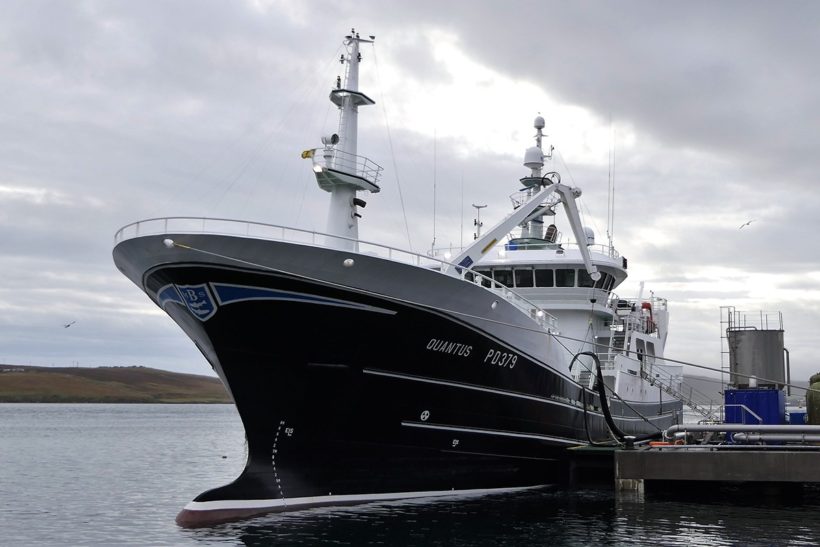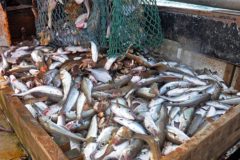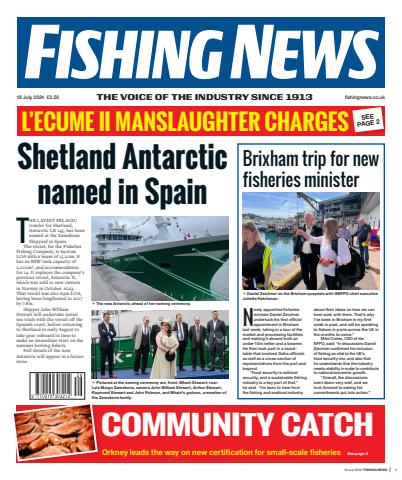Their efficiency, coupled with the nutritional benefits of the catch, makes pelagic vessels part of the climate solution, writes Ian Gatt, chairman of the Scottish Pelagic Sustainability Group
The recently published report from the Intergovernmental Panel on Climate Change (IPCC) made grim reading, with UN chief António Guterres describing it as a ‘code red for humanity’.
He said that the world must ‘wake up’ and act on climate change following the report, which warned that a target of limiting global warming to 1.5°C will be breached within two decades. Measures that must urgently be adopted and a framework for change will very much be the focus of the COP26 climate talks in Glasgow.
One of the largest, and rapidly increasing, contributors to greenhouse gas emissions is the global food production sector, which is estimated to produce 21-37% of the total human-created greenhouse gas emissions worldwide. Of this, 9-14% is attributed to crop and livestock agricultural activities, but only 4% to seafood production.
Seafood from both wild-capture fisheries and aquaculture accounts for approximately 17% of the global population’s dietary animal protein intake. For over two-fifths of the world’s population, this figure increases to 20% of dietary animal protein intake.
With the projected population growth by 2050 and a commitment to meeting the UN’s sustainable development goals, strategies for climate-smart food systems need to be identified and developed. Climate-smart food systems are those which meet the following criteria: they are either carbon-neutral or relatively low in greenhouse gas emissions; they are resilient against climate change and extreme weather events; they have the ability to be sustainably increased to meet growing demand; and they support the provision of a nutritious diet.
Scottish pelagic fisheries (mackerel, herring and blue whiting) make up 64% of all Scottish-landed fish, with a value of £218m in 2020. But where do Scotland’s pelagic fisheries stand within the overall carbon footprint created by global food production? A recent scientific article by Dr Frances Sandison shows that Scottish-caught pelagic fish have the lowest carbon footprint and environmental impact compared to other seafood products such as UK farmed salmon, which is over seven times higher.
To put this into further context, wild-capture seafood production in general has a much lower carbon footprint than all land-based meat production, especially beef and lamb. Other research indicates that pelagic and other wild-capture fisheries have a lower carbon footprint than many plant protein sources, including grains, tofu, pulses and peas.
This confirms that sustainably managed Scottish pelagic fish represents a climate-smart food source that will help to deliver the Scottish government’s commitment to reaching net-zero carbon emissions by 2045 (the UN target is 2050).
It’s well known that pelagic fish are incredibly nutritious, being full of heart-healthy Omega 3 fatty acids, as well as essential vitamins and minerals. A scientific article published in 2019 by Dr Elinor Hallström and colleagues in Sweden, which shows that mackerel, herring and sprat top the ranking table for combined lowest climate impact and greatest nutritional value, is another great reason why consumers should be eating more Scottish pelagic fish.
According to research, if someone consistently substituted one weekly meal of beef for pelagic fish, the carbon footprint would be reduced by 30%. The figures for lamb and chicken are 10% and 9% respectively. Market research has shown that consumers are more likely to buy a product with a low carbon footprint. Much more work needs to be done on ensuring that seafood is eco-labelled in a way that conveys this message in a coherent and easily understandable way that can be scientifically verified and audited.
Some environmentalists have long criticised Scotland’s pelagic sector because the boats that participate in the fishery are large and therefore require a lot of fuel – which Dr Sandison’s lifecycle assessment of the fishery shows is the single biggest contributor (~95%) to its carbon footprint. But when this consumption is translated to how efficient the fleet is at catching fish, the result is that it has the lowest fuel consumption per kg of fish caught (i.e. its carbon footprint).
What’s more, these vessels are all family-owned and crewed by local people, who have invested heavily in modern vessels with technology aimed at continuously improving efficiency. Thus, a relatively small number of state-of-the-art vessels catching herring and mackerel for only a few weeks in the year is a more environmentally friendly option than having numerous small craft plying our waters in a bid to attain the same national catch levels.
Similarly, pelagic processors have invested in the latest production equipment that ensures a high-quality and low-carbon-footprint product, which can be delivered to market in the most efficient manner.
Where possible, our fishers will look to do more to reduce their environmental impact, including enhancing fuel efficiency through future innovations in vessel design and fishing practices. The IPCC report highlights that change in our lifestyles must be brought about. Scotland’s fishermen, whether operating large vessels or small craft, are proud that the food they put on our plates already has a low carbon footprint, and will strive to further reduce emissions over the coming years.
Dr Sandison’s research, ‘The environmental impacts of pelagic fish caught by Scottish vessels’, was carried out as part of her PhD and funded by the Scottish Pelagic Sustainability Group, Shetland Islands Council, the University of Aberdeen, the University of the Highlands and Islands and Shetland Fish Producers’ Organisation. It can be read here.
The paper by Dr Hallström et al, ‘Combined climate and nutritional performance of seafoods’, can be read here.
This article is from Fishing News’ special feature on industry responses to the climate crisis as part of the COP26 conference in Glasgow. Subscribe to Fishing News here or buy the latest single issue for just £3.30 here.






